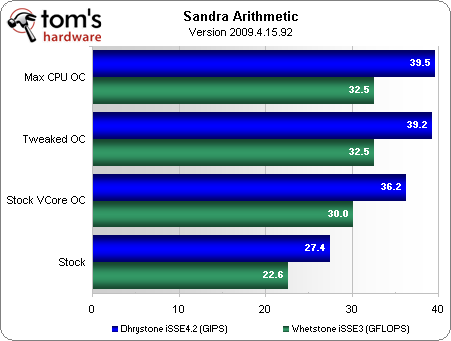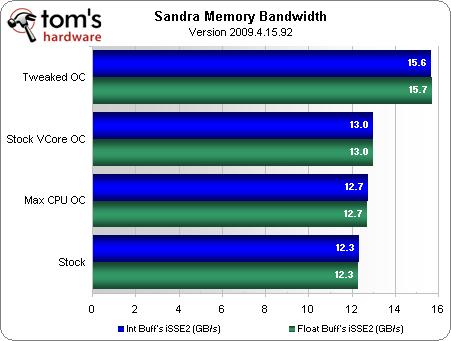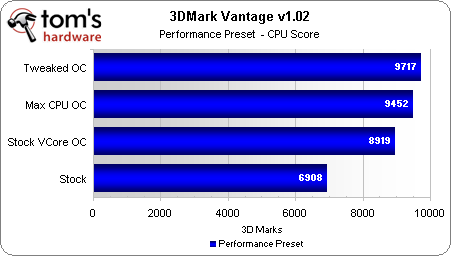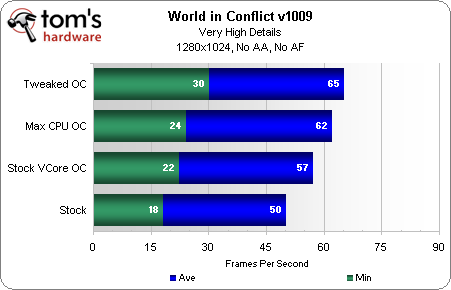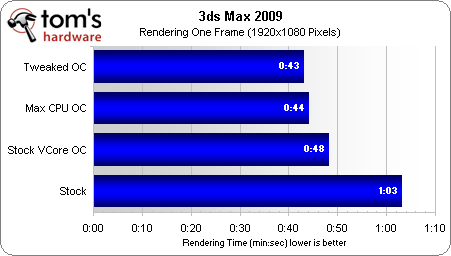Making Lemonade: Overclocking Your Locked AMD Processor
Benchmark Results: Performance Gains
Performance Gains
While this article is more of a “How To” guide than a benchmark roundup, we still wanted to take a brief look at the performance achieved with our overclocking efforts. If you jumped straight to this page, be sure to note the chart on the preceding page detailing the overclocked settings used for testing.
In the Sandra CPU Arithmetic test, the scores increase according to core speed, but our Tweaked OC shows no gains resulting from the overclocked northbridge.
Overclocking the northbridge yields significant gains in memory bandwidth. The Tweaked PC leads the way, while the slightly lower NB speeds of the Max CPU OC cause it to trail the Stock Vcore OC.
Overclocking our Phenom II processor results in sizeable gains in the 3DMark Vantage CPU test. Additional memory bandwidth from increasing the northbridge speed raises the score even higher.
World in Conflict is quite CPU–intensive. Testing a low resolution without FSAA allows us to use very high details and still not be GPU-limited with the Radeon HD 4870. It’s no surprise that the minimum and average frames per second (FPS) both increase as we raise the CPU’s core speed. But notice the significantly better minimum FPS achieved by raising the northbridge speed. Memory controller performance and L3 cache speed are obviously important here, since tweaking the NB resulted in the same 6 FPS increase in minimum frame rates, as did the 1,100 MHz CPU overclock.
Overclocking the CPU significantly lowers the rendering time in 3ds Max 2009. Memory bandwidth didn’t come into play too much here, as further overclocking of the northbridge only provided an additional one-second reduction.
Get Tom's Hardware's best news and in-depth reviews, straight to your inbox.
Current page: Benchmark Results: Performance Gains
Prev Page Test System Configuration And Benchmarks Next Page Benchmark Results: Memory Tweaking-
sohei it's about how to squeeze all performance from an locked cpu .Reply
this is a pro' article (head shot) -
brisingamen great article, should be more like it,Reply
and a few more gaming benches wouldnt hurt either guys!
speaking of headshots yes unreal tournament is probably the most important game to exemplify the value of overclocking and added framerates due to "headshots" and shtuff.
keep up the good work! -
Onus stray_gatorWhat's the point of using a high-end mobo to overclock a mainstream/value cpu?Fair question; no one would likely do this IRL, but I think the point here was to see how high the locked CPU could go, so they used a premium mobo.Reply
Paul, now that we know what this specific CPU can do, would it be useful to now put it on a more typical mainstream mobo and see what one might get from the same chip under more typical conditions?
The point would be to answer the following: if my budget just grew by $25, does it make more sense to buy a BE CPU or to get a more premium mobo? -
haplo602 stray_gatorWhat's the point of using a high-end mobo to overclock a mainstream/value cpu?Reply
because value mobos vary in stability much more than premium mobos. this article was just about the CPU limit, not the mobo limit. -
Tom's should do a shoot-out between an i7 920 and a 965BE that's had the multiplier taken down to 13x(2.6ghz), then both OCed to the max on the northbridge alone. I'm sure that would close the gap atleast somewhat, but I'm interested to see exactly how much. Maybe they could screw around with the HyperTransport multiplier as well, it might turn out that AMD has been shooting itself in the foot with the unlocked multiplier, when more performance would be had if they were forcing people to use the northbridge.Reply
-
Shadow703793 Good write up; but PLEASE do NOT recommend OCing via Windows. Most pro's here will tell you that same thing. BIOS > Windows for OCing.Reply
